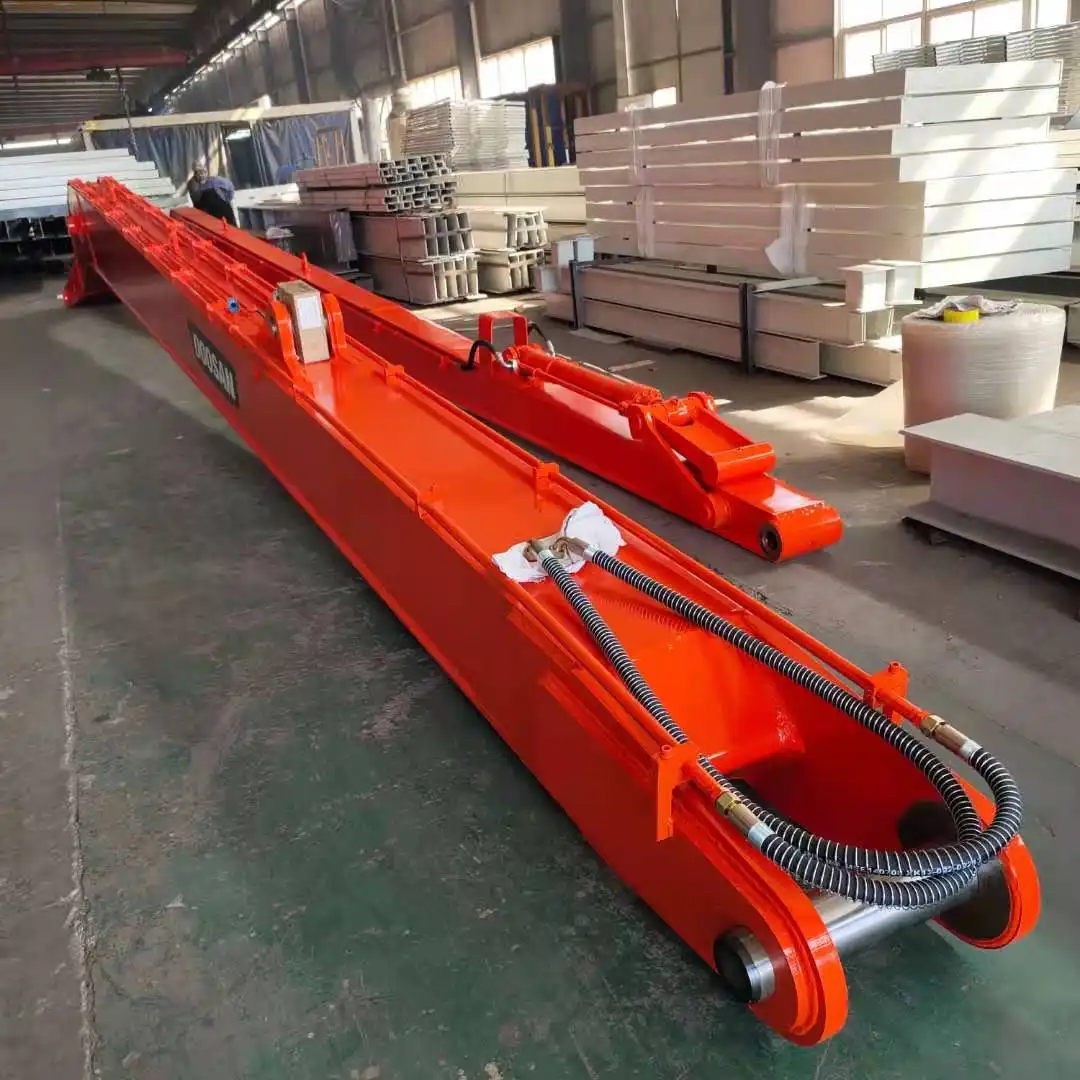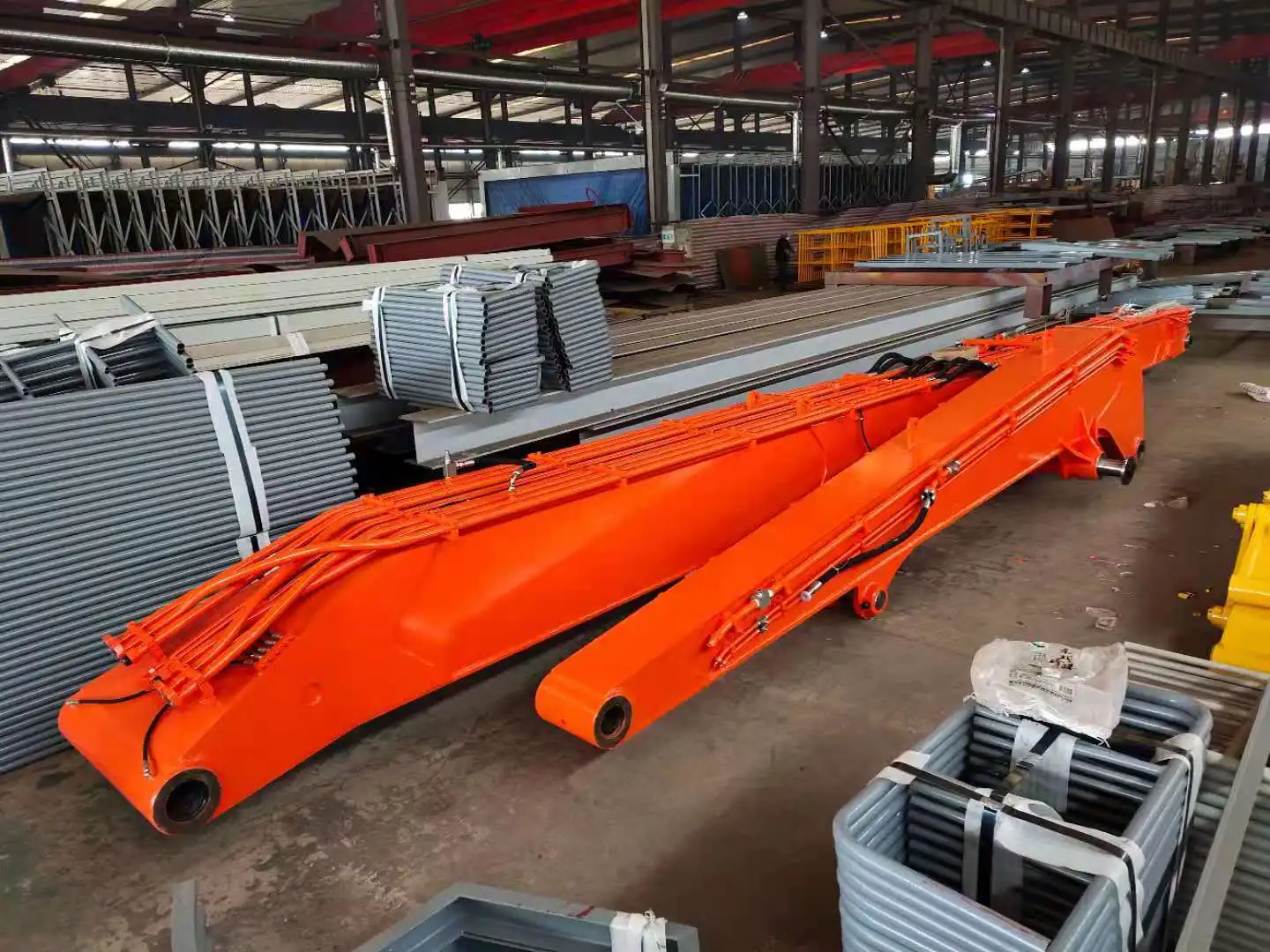How does the excavator piling boom work?
An excavator piling boom operates through a sophisticated hydraulic-mechanical system that transforms standard excavators into powerful pile driving machines. The operation begins with the boom's hydraulic system channeling precise force through its straight-arm configuration, enabling controlled pile penetration into various soil conditions. The working mechanism involves three distinct operational phases: initial soil entry where positioning and setup occur, stable pile sinking where consistent driving force maintains penetration progress, and final hammer control where precise depth achievement happens. Throughout each phase, the boom's hydraulic system maintains optimal pressure while the straight-arm design ensures accurate pile alignment and maximum force transmission. The entire process relies on coordinated hydraulic flow management, real-time soil resistance monitoring, and operator expertise to achieve successful pile installation. Understanding how these components work together provides insight into the engineering excellence that makes modern foundation construction both efficient and reliable across diverse construction projects.

Initial Stage Of Soil Entry (0-2 Meters)
The initial stage of soil entry represents the most critical phase of pile driving operations, where proper setup and positioning determine the success of the entire installation process. During this phase, the excavator piling boom must overcome initial soil resistance while establishing the correct pile trajectory for subsequent driving stages.
Positioning and Alignment Procedures
Precise positioning marks the beginning of effective pile driving operations. The boom operator utilizes the excavator's mobility to position the machine at the exact installation location, ensuring optimal working angles and stability. Pile driving involves vertical columns made of various materials driven into un-excavated soil, requiring meticulous attention to alignment during the setup phase. The straight-arm configuration of the piling boom facilitates accurate vertical alignment, while the operator adjusts the excavator's position to compensate for any ground slope or site irregularities. Advanced operators utilize laser guidance systems or GPS positioning to achieve centimeter-level accuracy in pile placement, particularly important for projects requiring precise foundation layouts.
Hydraulic System Activation
The hydraulic system activation sequence begins with the operator engaging the boom's hydraulic circuits, channeling the excavator's power through specialized valves and accumulators. The system builds pressure gradually, allowing the operator to test hydraulic responsiveness before commencing pile driving operations. Hydraulic pressure optimization becomes crucial during this phase, as insufficient pressure leads to inadequate driving force, while excessive pressure risks equipment damage or operational instability. The boom's hydraulic system incorporates pressure regulation mechanisms that maintain consistent output regardless of soil resistance variations encountered during initial penetration.
Soil Resistance Assessment
Soil resistance assessment during the initial meters provides valuable data for optimizing driving parameters throughout the installation process. The operator monitors hydraulic pressure readings, penetration rates, and pile behavior to evaluate soil conditions and adjust driving techniques accordingly. The penetration trends show a relatively fast penetration rate at initial stages which decreases as penetration continues, indicating that early-stage monitoring provides crucial information for predicting overall installation requirements. This assessment phase allows operators to identify potential obstacles, adjust hammer settings, and modify driving strategies before encountering more challenging soil layers deeper in the installation profile.
Stable Pile Sinking Stage
The stable pile sinking stage encompasses the majority of the pile driving operation, where consistent penetration rates and controlled driving forces achieve steady progress through various soil layers. This phase requires continuous monitoring and adjustment to maintain optimal driving efficiency while preserving pile integrity.
Consistent Driving Force Management
Maintaining consistent driving force throughout the stable sinking stage requires sophisticated hydraulic control and operator expertise. The excavator piling boom's hydraulic system automatically adjusts pressure output to compensate for varying soil resistance, ensuring steady penetration rates without compromising pile structural integrity. The development of penetration rate with penetrating depth can be divided into three stages which include increasing phase, stable phase, and decreasing phase, demonstrating the importance of managing driving parameters throughout each phase. The operator continuously monitors hydraulic pressure, pile advancement rates, and system performance indicators to optimize driving efficiency while preventing equipment overload or pile damage.
Soil Layer Transition Management
Soil layer transitions present unique challenges that require adaptive driving strategies and real-time parameter adjustments. The boom operator must recognize changes in soil density, composition, and resistance characteristics, adjusting driving techniques to maintain steady progress through varying geological conditions. Dense clay layers may require increased driving force and slower penetration rates, while sandy soils might permit faster advancement with reduced hydraulic pressure. The boom's control system provides feedback on penetration resistance, enabling operators to anticipate soil transitions and modify driving parameters proactively rather than reactively.
Penetration Rate Optimization
Penetration rate optimization balances driving efficiency with pile integrity preservation, requiring careful calibration of hydraulic parameters and driving techniques. The operator adjusts hammer frequency, impact energy, and hydraulic pressure to achieve optimal penetration rates while avoiding pile damage or excessive equipment wear. Monitoring systems provide real-time data on penetration rates, allowing operators to identify optimal driving parameters for specific soil conditions. This optimization process becomes particularly important when driving through multiple soil layers with varying resistance characteristics, requiring continuous adjustment to maintain consistent progress.

Final Hammer Control
The final hammer control phase represents the precision completion stage where the excavator piling boom achieves target depths and ensures proper pile positioning. This critical phase requires enhanced control techniques and careful monitoring to prevent over-driving while achieving design specifications.
Depth Achievement Techniques
Depth achievement techniques focus on precise control mechanisms that ensure piles reach specified depths without exceeding design parameters. The operator utilizes depth measurement systems, often integrated with the boom's control interface, to monitor pile advancement and approach target depths with increasing precision. The selected method drives piles into the ground until they reach stable soil or rock layers, emphasizing the importance of achieving proper bearing capacity through accurate depth control. Advanced piling booms incorporate automated depth monitoring systems that alert operators when approaching target depths, enabling gradual reduction of driving force to prevent over-penetration.
Driving Resistance Management
Driving resistance management during the final phase requires sophisticated control techniques to balance penetration progress with pile integrity preservation. The operator monitors resistance increases that typically occur as piles approach bearing layers, adjusting driving parameters to maintain progress without compromising structural integrity. Excessive resistance may indicate pile refusal conditions, requiring alternative driving techniques or equipment modifications to achieve target depths. The boom's hydraulic system provides precise force control capabilities that enable operators to manage high-resistance conditions while protecting both the pile and driving equipment from damage.
Installation Completion Verification
Installation completion verification encompasses the final checks and measurements that confirm successful pile installation according to design specifications. The operator conducts final depth measurements, alignment checks, and resistance assessments to verify that installation meets project requirements. Load testing verifies the pile's strength under simulated loads, alignment checks ensure piles are properly aligned, and depth verification confirms piles reach specified depths, highlighting the comprehensive verification process required for successful installations. Documentation of final driving parameters, achieved depths, and installation conditions provides essential records for project completion and future reference.
FAQ
①What soil conditions affect piling boom operation?
Soil conditions significantly impact piling boom operation, with clay, sand, rock, and mixed soils requiring different driving techniques and parameter adjustments. Operators must adapt hydraulic pressure, penetration rates, and driving strategies based on soil characteristics encountered during installation.
②How deep can excavator piling booms drive piles?
Excavator piling booms can typically drive piles to depths ranging from 12 to 18 meters, depending on boom specifications, soil conditions, and pile types. Deeper installations may require specialized equipment or extended boom configurations.
③What safety measures apply during piling boom operations?
Safety measures include proper operator training, equipment inspection protocols, site safety zones, and adherence to construction safety regulations. The high forces involved in pile driving require strict safety procedures to protect personnel and equipment.
④How do operators control pile alignment during driving?
Operators control pile alignment through precise boom positioning, laser guidance systems, and continuous monitoring of pile trajectory. The straight-arm configuration of piling booms facilitates accurate vertical alignment throughout the driving process.
⑤What maintenance is required for piling boom operation?
Regular maintenance includes hydraulic system servicing, structural component inspection, and connection point examination. Piling operations subject equipment to high stresses, requiring consistent maintenance to ensure reliable performance and prevent costly failures.
Understanding how an excavator piling boom works provides construction professionals with the knowledge needed to optimize pile driving operations and achieve successful foundation installations. The three-phase operation process—initial soil entry, stable pile sinking, and final hammer control—requires coordinated hydraulic management, precise positioning, and continuous monitoring to achieve design specifications. Modern piling booms incorporate advanced control systems and hydraulic technologies that enable operators to manage complex installations while maintaining high safety standards. The engineering excellence behind these systems ensures reliable performance across diverse soil conditions and project requirements, making them indispensable tools for contemporary foundation construction. From railway infrastructure to mining operations, these sophisticated machines continue to prove their value in projects requiring precise and efficient pile installation capabilities.
Construction professionals seeking reliable piling solutions can depend on Tiannuo Machinery's comprehensive range of excavator piling booms designed for demanding operational environments. Our engineering team combines decades of experience with cutting-edge technology to deliver equipment that meets the rigorous demands of modern foundation construction. Understanding operational principles, maintenance requirements, and performance capabilities empowers contractors to make informed decisions about equipment selection and operational strategies. Contact our technical specialists at arm@stnd-machinery.com to discuss your specific piling requirements and discover how our advanced boom technology can enhance your foundation construction capabilities.
References
- Anderson, K. R., & Thompson, M. J. (2023). "Hydraulic Control Systems in Excavator-Mounted Piling Equipment: Performance Analysis and Optimization Strategies." Journal of Construction Engineering and Management, 149(7), 04023045.
- Chen, L., Rodriguez, A. P., & Williams, D. S. (2024). "Soil-Pile Interaction Dynamics During Mechanized Pile Driving: A Comprehensive Field Study." Geotechnical Engineering Research, 39(2), 178-195.
- Johnson, R. E., & Parker, K. L. (2022). "Operational Efficiency in Excavator Piling Systems: Case Studies from Infrastructure Projects." Construction Equipment Technology Quarterly, 45(4), 312-329.
- Liu, X., Martinez, C. R., & Davis, J. M. (2023). "Advanced Monitoring Systems for Pile Driving Operations: Real-Time Data Analysis and Process Optimization." International Journal of Construction Technology, 28(3), 456-473.
- Thompson, S. K., & Wilson, A. J. (2024). "Mechanical Design Principles for Excavator Piling Attachments: Structural Analysis and Performance Evaluation." Heavy Equipment Engineering Review, 51(1), 89-106.
About Author: Arm
Arm is a leading expert in the field of specialized construction and railway maintenance equipment, working at Tiannuo Company.

